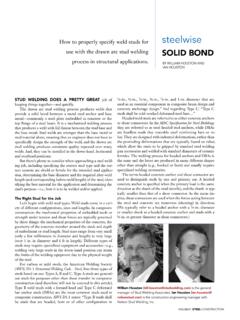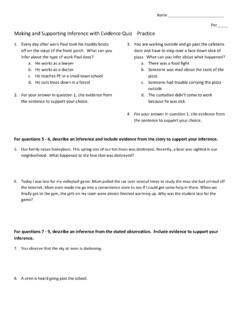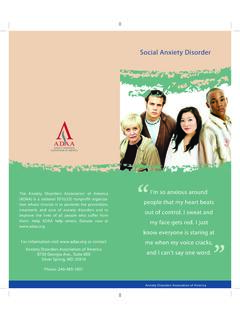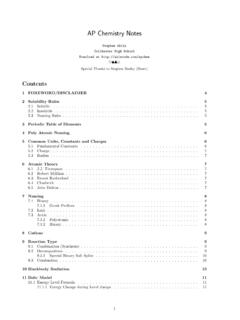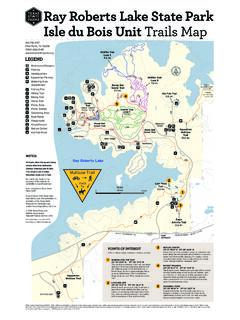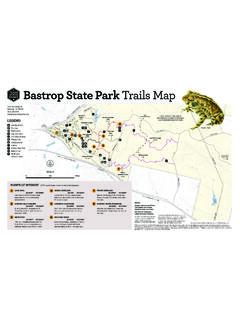Transcription of 30 Mile Cycle Beginner Training Plan - cancerresearchuk.org
1 30 Mile Cycle Beginner Training Plan Contents 01 Introduction Page Welcome 3. Who is the Training plan for? 3. Safety First 4. Health-status safety checklist 4. 02 Getting Started What gear do I need? 5. Training 8. Where 8. When 8. Principles of Training 8. Structuring sessions 9. How to stretch 10. 03 Nutrition and hydration 11. 04 Tips and advice 12. 05 Training Plan Lead in Training plan 13. Main eight week Training plan 16. 06 Motivation 21. 07 Good Luck So, what next? 22. 2. Introduction Welcome to your 30 mile Cycle Beginner Training plan! A 30 mile Cycle ride is a hugely rewarding event to compete in. It serves both as an ideal introduction to longer distance cycling and is also a meaningful challenge in its own right. Completing a 30 mile event is a great achieve- ment wherever you finish and this Training plan takes you through to race day and includes a multitude of tips and advice to help you reach your cycling goal.
2 The Cycle -fit Training plans are specifically designed by fitness experts to safely progress your fitness to the appropriate levels so that you will not just be able to complete the challenge but you'll be able to complete it comfortably. Each Training plan is based around specific cardiovascular (CV) Training . They also include a range of dedicated resistance and flexibility Training exercises, which will improve your total body fitness and provide you with the all-round strength and fitness that you'll need. Who is this Training plan for? This Training plan is suitable for all fitness levels as it steadily builds your fitness over eight weeks, but if you have not exercised for some time then the specific lead-in Training plan (which is a precursor to the main schedules) will ensure that you can cope with the level of Training .
3 The Training plans are carefully structured and cover everything that you need to do for your fitness preparation, so all you need to focus upon is forward planning and beginning sooner rather than later. Kick-starting your fitness is the first step in achieving your goal. Enjoy your Training ! 3. Safety First To start with, it is vitally important to ensure that it is safe for you to begin an exercise programme. Complete the safety checklist below and if you answer YES to one or more questions, or alternatively, if you are at all concerned about starting Training , then make an appointment with your doctor for a check-up before you start. Health-status safety checklist: 1. Are you aged over 30 and/or have not exercised for some time? Y N. 2. Do you suffer from any medical conditions? Y N.
4 3. Are you a smoker or have recently given up smoking? Y N. 4. Have you undergone any surgery in the past two years? Y N. 5. Are you suffering from any injuries? Y N. 6. Are you currently on any prescribed medication? Y N. 7. Are you unsure about beginning an exercise programme? Y N. Once you have the all-clear from your doctor then you're ready to start Training . 4. Getting Started What gear do I need? Choosing a bike It's vital to choose the right bike before embarking on your Training programme. Road biking relies on quality kit as well as quality technique. Here's how to choose that all-important first bicycle. Buying a bike is akin to buying a computer; the choice is enormous and can be bewildering. Road bikes are fast and generally have thin tyres, rigid frames and drop down handlebars.
5 They have not changed as much as their mountain bike counterparts over the last 15 years, but there is still a lot to think about when purchasing a road bike. Bicycle cost When it comes to bike price, more is definitely less. The more you pay, the lighter the bike, and in theory, the lighter the Cycle , the better it is. Cyclists are obsessed with weight, often going to the extreme of drilling holes into certain components to make them lighter! You should buy the lightest version you can afford. At the end of the day you get what you pay for. Quality is expensive, but cheap bikes may well put you off cycling altogether. Pick up a lot of bikes and compare the weights of similar models. This will give you a good indication of the true worth of that weight saved. Bikes under 100. There are plenty of bikes in this price range available, and they represent very good value for money as long as you only use them to travel short distances and don't give them much abuse.
6 However, if you actually want to use them for any form of Training , they are best avoided. Bikes between 200 and 500. You should expect these models to have better specifications and to be lighter than the cheap bikes, but don't expect it to have the best components or be extremely lightweight. For most people, though, this is plenty to spend on a bike and if you look around you can get a very good model for this price. Bikes of 500 upwards Some bikes are on sale for thousands and thousands of pounds, but this is the range you will need to think about if you are going to train seriously or race. Bikes in this price range will be lightweight, strong, and will have well specified components. 5. What gear do I need? Making the Cycle purchase After you have decided on the type and cost of your bike, it is very important to be measured up correctly so the bike fits your body style.
7 Too many people buy a bike and just get on and ride, in whatever the default position seems to be. If you buy the bike from a professional bike retailer, then they should set it up for you when you buy it; if not, ask them to. Once the bike has been correctly set up, make sure you know how to set it up yourself in case you ever take it apart. Write down the settings and leg lengths, or better still mark on the bike itself to indicate your settings. Road biking gear guide Getting the right kit for a fit and healthy Cycle No matter how dedicated you are to road biking, you won't enjoy any health benefits from cycling without the right bike kit. A safe helmet and a water bottle are as vital as strong muscles. Here's the essential guide to choosing the right bike kit before you get going in the world of cycling.
8 Cycle helmet Nearly 80 percent of Cycle -related deaths result from head injuries, so riding without a helmet is not an option. You absolutely must wear one. As well as that startling fact, prices for a good helmet are between 25 and 35, so there really is no excuse. Here's what you should look for when choosing your helmet: A peak to keep the sun or mud out of your eyes A main strap that fastens under your jaw A helmet that is adjustable, so it is not too tight and feels comfortable A close fit on your head and doesn't rattle around Lightweight, with plenty of vents Made by a reputable manufacturer and retailer It has the appropriate safety approval sticker inside. In the UK look out for the CE logo inside the helmet Cycling sunglasses It's always useful to have a pair of glasses on when you're cycling, whether it's the middle of summer or the depths of winter.
9 There always seems to be something flying around that has your eyes as its target. The best ones are those where you have interchangeable lenses. Normally you get a set of three; clear, tinted for the sun, and orange to improve light quality. Cycling gloves When choosing your gloves you need to consider four main areas: comfort, sizing, warmth and protection. Padded gloves are useful to increase comfort. Avoid excess padding though as too much can compress the nerves in the hands. Before buying gloves, measure around your knuckles and measure the length of your dominant hand. This will ensure you choose correctly fitting gloves. Bike water bottle If you're heading out for a long bike ride it's really important to take plenty of fluid with you. You can fix two water bottle holders on most bikes and it is well worth doing.
10 You could put water in one and an energy drink in the other. 6. What gear do I need? Accessories The only essentials are a puncture repair kit, a pump, a small toolkit, a trip computer, sunscreen, lip-salve, personal toiletries and a small first aid kit. Everything else is a luxury. Turbos - There is a wide variety of gadgets available, costing from a few pounds to a few hundred, but if you are serious about Cycle Training then eventually you may want to get a turbo trainer. This is the equivalent of a running machine for your bike and allows you to train safely at home whilst in front of the TV. You can also use them when the weather is really bad for cycling, such as when it is wet or icy. Turbos are great if used correctly, but can make for quite boring exercise time. However, you can at least watch TV or listen to the radio to pass the time while you Cycle .


